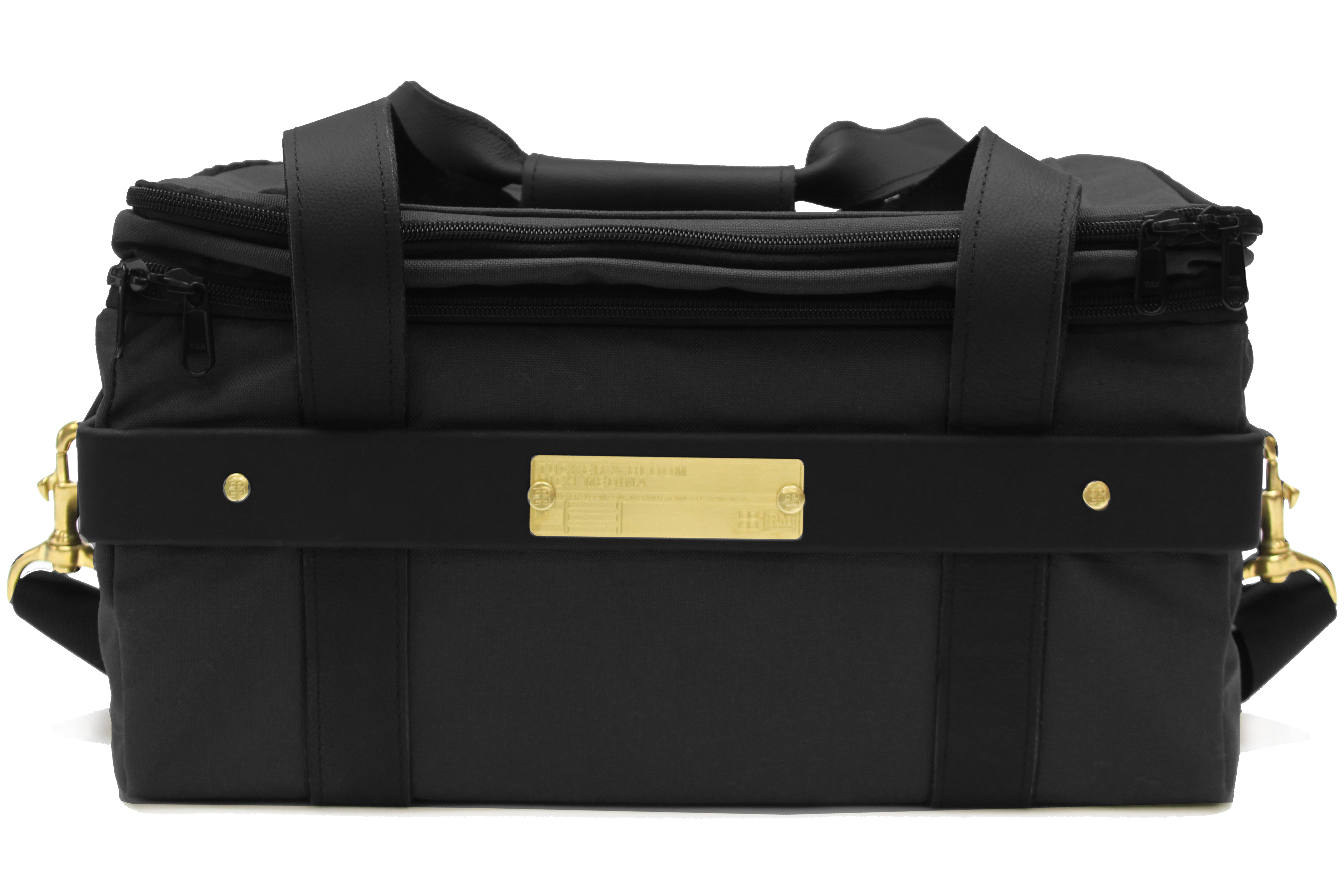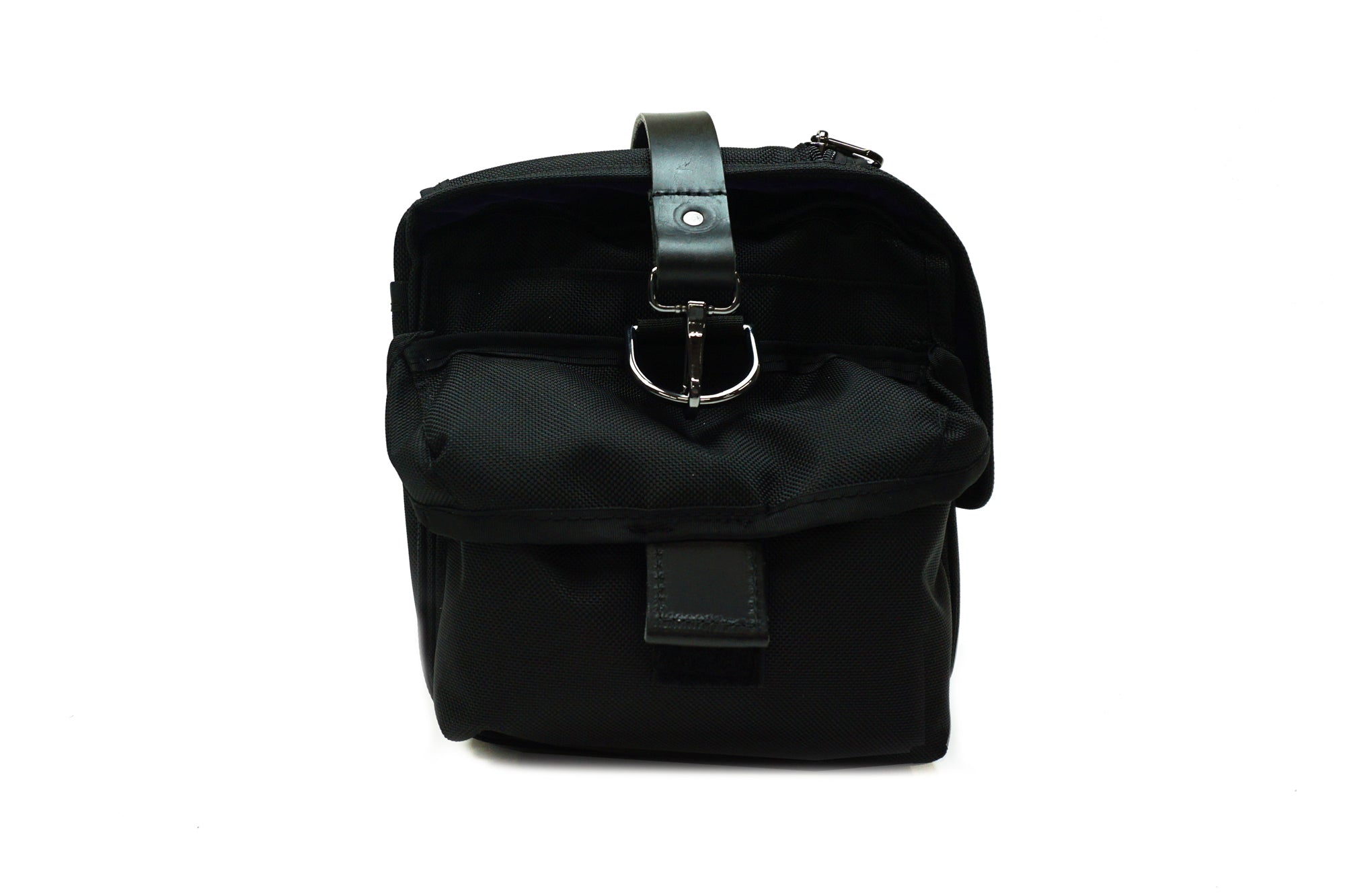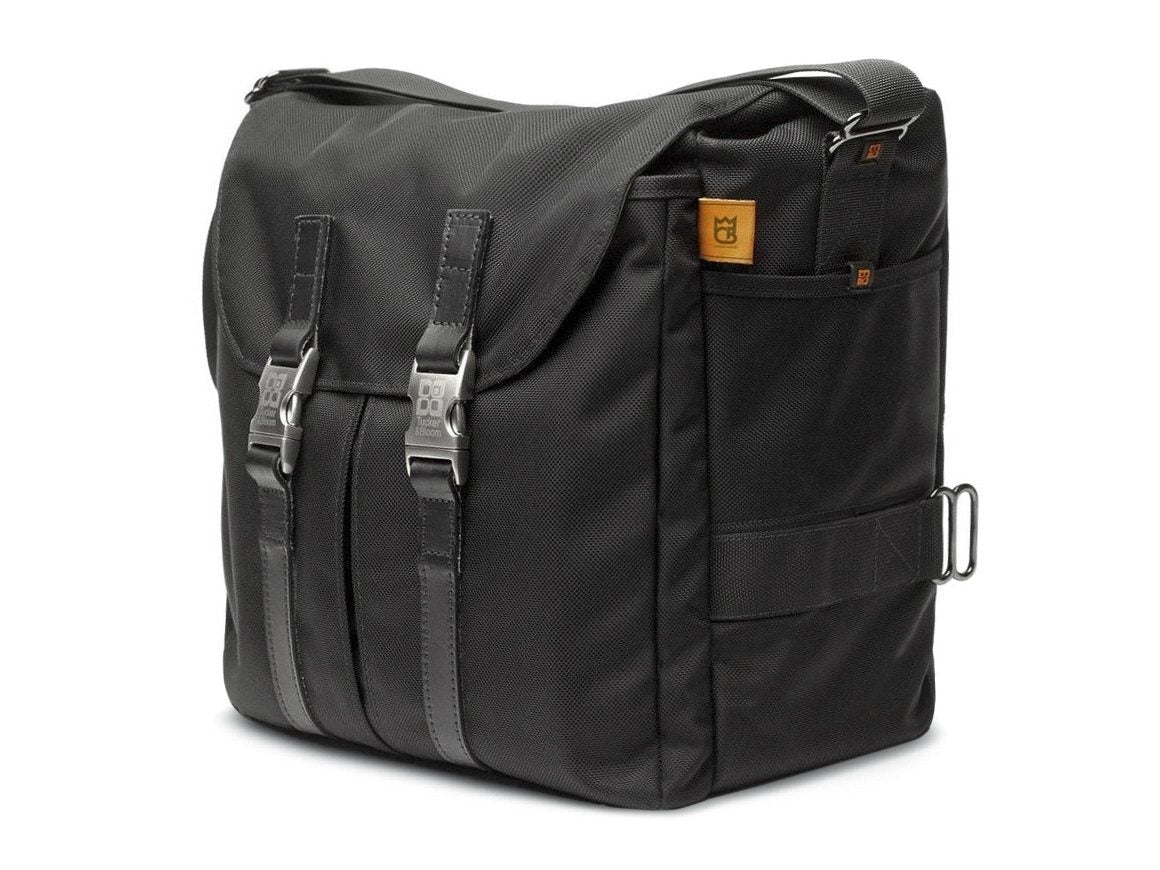We we're recently interviewed by Nashville based Native Magazine about the founding of our company, the development of it, and the difficulty the interviewer, Jon, had finding our facility.

No one knows where Tucker & Bloom is. Never heard of it. That’s the first thing you learn when you’re trying to find Tucker & Bloom.
The internet sure as hell knows who Tucker & Bloom is. Sites are glutted with glowing reviews of the company’s bags. They’re legendary in the worldwide record community thanks in part to a collaboration with iconic DJ Rich Medina. And just in time for last year’s gift-giving season, Jack White’s Third Man Records (motto: “Your Turntable’s Not Dead”) announced a special edition of the company’s popular North To South Messenger Bag, which can hold twenty or more records. Tucker & Bloom have a distributor in the high-end Asian markets, and like that Tom Waits song, they’re big in Japan.
But in East Nashville, the floating blue dot of my GPS says I’m here, and I’ve parked in a strip mall off Main, confident I’ll be able to see it. Or Maybe if I walk a little bit, I’ll see it.
I don’t see it.
There’s no Tucker & Bloom marquis in lights or a storefront of sparkling glass; I just see north Gallatin, with its beauty supply stores and cell phone shops and gyro palaces. A barbeque grill that looks like a modified oil drum is belching smoke into the light snow that’s coming down.
Case Bloom, the younger half of the father-and-son business, will later describe their company as serving “a global market, but niche. We have to look at them first and foremost.” Because of that, Tucker & Bloom don’t mind a well-hidden location, and they’ve succeeded, because the people I’ve asked—two women leaving a salon, the owner of the barbeque place—have no idea. My interview is supposed to be right now. So I call.
“Can you see a building with an underwater mural on it?”
It’s fifty feet ahead, and I walk toward it, hooking left down a long parking lot lined with brown, subdivided factory spaces that seem to get bigger the farther I go. These aren’t retail shops; these are the laboratories of mad craftsmen with dust in their eyebrows. In the back corner, where the building forms the crook of an “L,” Case pops his head out the door to make sure I find him. A small Tucker & Bloom sticker in the corner of the window belatedly announces I’ve arrived.
Case is a compact man, efficient, and young, with an intense personality that doesn’t waste words. He’s wearing a beanie and a sweater and a week’s worth of black beard; if it wasn’t for his manner, you’d expect him to be loitering in a coffee shop.
The factory layout was designed by Case’s father, David Bloom, the other half of the company, based on his experience working for a Japanese fashion company with a factory in Long Island City. It’s split between two floors, with the cutting room above. But this isn’t so much a sweatshop as it is a toyshop, and from the sewing machines in the center of the room, the detritus of avant garde design gets pushed to the edges: prototype bags clutter an old couch next to David’s desk in the corner, and oil paintings and photography look down at the workshop from the walls.
David Bloom is reclining in an office chair in the back corner where his workspace is. He’s fifty-nine, with chunky tortoiseshell glasses and a white, grizzled beard somewhere between a week or two old, the kind cowboys would grow on a cattle drive. Which is fitting considering David has worked with leather for over thirty years in the fashion industry. He’s done it all from building his own line when he was twenty-one to running it for eight years before he began contracting with high-end brands like Couregé, Valentino, Hartmann, and Coach. And it shows in his body language: a steady slouch back in the seat and crossed legs which seem to say that at this point in his life, there is nothing new under the sun.
I ask Case what it’s like, growing up the son of a bagman. “Rolls of leather were stashed away where normal people might keep canned goods,” Case says. “There were leather scraps everywhere. And then there was the smell of it—just being around it all the time.”
There were the childhood vacations, where David would make Case a bag out of bark or some other alternative material. “I remember being in third, fourth grade, and coming up with some idea and talking to him about it, and then we would figure out how to make something,” Case says. “It’s always been our relationship, bouncing ideas back and forth.”
It’s not long before Case and David start to swap family stories.
David remembers, “When Case was very young, he used to make macramé products. I remember clearly having the discussion with him about how you need to price these things so you make money. The whole idea of paying yourself, not just—“
“Covering materials,” Case says.
“Covering materials, yeah,” David agrees. “You need to understand what you want to make on an hourly basis and what it takes for you to do that, and the profit margin. It was Business 101.”
But David never pressured Case to get into bags. These were discussions more about the business of art in general, which Case was pursuing, working in oils and charcoals at Hume Fogg and then later at Hillsboro High School. His art excelled even as he battled intense isolation. Uprooted from New York, he found himself in a city with a much smaller Jewish population than in the Northeast.
His childhood friend Amy Fleischer remembers that time. A few years younger than Case, she too attended public high school, which was abnormal for the Jewish community in the late ‘90s. “There are always those feelings of isolation when you’re an adolescent, but especially if you’re a little different,” Amy says. Of her 500-person graduating class in Brentwood, there were maybe five Jewish students.
“I remember being just a total outsider, feeling that way at least,” Case says, talking to his fingers in his lap. “We’re Jewish, and everybody is Christian, and I was this ambassador for the Northeast, and Jews in general. It was totally bizarre.”
He’d already been accepted into Pratt Institute, an art school in Brooklyn famous for its programs in design, and David was splitting time between Nashville and New York, where he was working as a designer for Coach. Nashville was a wonderful city, David remembers thinking, but his family belonged with him and his work was in New York. So, in the late months of 2001, just as Case was beginning his senior year, the family put a “For Sale” sign in the front yard of their Nashville home.
“Then 9/11 happened,” Case says, “and essentially, the industry collapsed.”
David watched the planes hit the towers from the sample room window at Coach on 33rd and Avenue of Americas. His apartment was a block away from the World Trade Center. “It was surreal,” he says, shaking his head. “The whole thing was surreal.”
Case, back in Nashville, was pulled out of class with his sister. They tried to call their father, but cell phones were down. “I’d spent the summer in New York living with David and going to Pratt, taking the train from the World Trade Center to his apartment every day. It happened so early, we were thinking that he took the train, and he’s at the bottom of the rubble,” he says.
“I felt really disconnected because I felt like I was here, he was there, and I was supposed to be there, and then I saw the entire neighborhood…blow up on TV. Everything I knew as home there just…went. Yeah, it was terrible, man. It was terrible.”
Fashion designers still talk about September 11, 2001, as a cataclysm for the industry. Labels went bust. Budgets shrank. Designers like David were cut. “The whole luggage industry took a nosedive after that. I mean, really bad,” he says. “It got me thinking about how small is beautiful. The idea of ‘huge’ being the critical importance for a business, particularly in the bag business, really shifted in my mind.”
It changed Case’s future, too. “I had to take a real hard look at what it meant to be an artist,” he says, “and the risks that are associated with that beyond just the short term.”
With uncertainty in the market, David lost his contract work for Coach and returned to Nashville.
“It was really sad to see it be disposable. His art and his craft were just gone,” Case says. “I saw the ripples, and they directly affected my family.”
You could say it made Case bitter, watching this through his senior year, seeing his father struggle, but it also made him meta about the life of the artist: “The artist is the first one to get canned whenever something goes down,” he says. “So that made me step back and examine what I was getting ready to go into.” Instead of Pratt, Case started business school at MTSU.
During this time, he had seen his father get work and lose work, “the struggle of being an independent contractor,” Case calls it. “Tucker & Bloom was necessity at a certain point. It was like, ‘How are we going to take control of this? When you’re the first one to get canned, how do we find some stability in that?’”
David was looking for an outlet for his design, and Case, with his developing business background, could help with the company face, business model, and input in product development. “It just kind of morphed into, ‘Okay, let’s build this website, here’s the logo, here’s the name, let’s get photos,’” Case says.
I ask for specifics on the date and they both laugh. “We always have problems with this one,” Case says. “We just need to come up with something.”
But while they might still be trying to assemble their mythology, their company name isn’t a mystery. Bloom is the family name, the artistic side with a rich history in design. While Tucker, Case’s middle name, is from his maternal side—whalers from the northeast. Outdoorsmen. “The idea is to bring design to function,” Case says.
“I think we both share this desire for design to fulfill a need. It’s not just aesthetically pretty,” he says. “Good design is intrinsically beautiful, but it’s based off of serving a purpose. So we look at how we can make a container that will fit this, this, this, and this elegantly.”
Case has continued to make art—he shows me some urban landscape prints he’s been working on—and he expanded into the music scene, becoming one of the driving forces in the emerging Nashville hip hop community. The Boom Bap, his monthly series at the 5 Spot that pulls world-renown DJs to spin, just celebrated its six-year anniversary and has expanded into Atlanta and Miami.
Like Tucker & Bloom, Case says The Boom Bap came out of necessity: “We wanted a place to play the records that we loved, and no one was really giving us that venue, so we decided to make it happen ourselves. And now it’s different. There are a lot of talented rappers and producers coming out of Nashville. They were here before, but I think that the light’s been shined, and they’re able to make moves.”
When you grow up with a father as a craftsman, it’s natural to be involved in that career, even without the parent weighing in. David’s father was a doctor in Boston, so was there ever a desire to go into medicine instead of fashion?
David thinks, then says, “No, because I was completely…” He looks into the rafters, the bottom of his cutting room floor.
“Disinterested?” Case says, and they both laugh.
“Left-brained person,” David says. “We just have different kinds of minds, that’s all.”
That’s true for not just David and his father, but for David and Case. What Case designs, David breathes into life, and it’s helped make them a respected name in a worldwide community, even if their Nashville location can be hard to find.
-Jon Gugala
Check out the Native interview on their site for more photos from the interview.
Record Bags
Record bags made for DJs or record buying folks. DJ Backpacks and messenger bags meant for holding 7” records, 45's, LPs, 12" singles, and virtually any other vinyl record format you can think of.
DJs require a specific type of bag, and that’s why we make our bags to the specifications and needs of working class DJs. Large enough to hold all types of vinyl, and padded enough to provide peace of mind that your precious LPs will make it from one gig to the next, without a scratch. From our larger 45 bag, made to hold a large assortment of records, to our dj backpacks and dj messenger bags, that are able to hold records and other necessary items, like cables, and laptops, we’ve got all the needs of a working class DJ covered.









